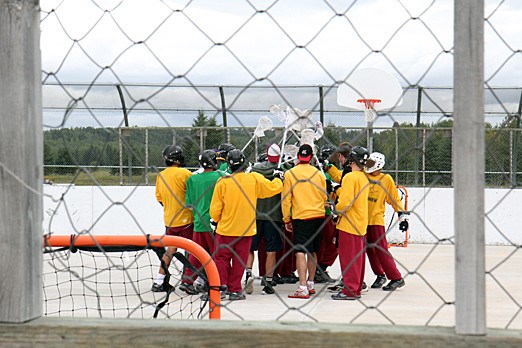Johnny never put much stock in the game of lacrosse.
Being a First Nation youth, he said he tried it once back home but never gave it much thought after that. It wasn’t until he found himself at the Justice Ronald Lester Youth Centre in Thunder Bay that he picked up a stick and gave it a shot.
“It’s much harder because there’s hitting and slashing,” Johnny said. “Where I played I couldn’t do that. I didn’t think lacrosse was that important at first but I had hoped it would make my life better. It’s good and it’s fun to play with my peers. I get to know them.”
This youth’s real name is not Johnny. In accordance with the Youth Criminal Justice Act, his true identity cannot be revealed, and to comply with the Act tbnewswatch.com will refer to the teen as Johnny.
Johnny and more than 10 other youth at the 16-bed Lester Centre participated at a lacrosse camp sponsored by Right to Play and the Thunder Bay Lacrosse League.
The goal of the program is to develop leadership skills for Aboriginal boys who will then take what they learn back to their communities. Right to Play partnered with the National Lacrosse League as well as the Ministry of Children and Youth Services to teach lacrosse to those at the correction facility.
The ministry provided $13,000 for the weeklong camp.
Johnny said he was happy to have participated and took on a leadership role by trying to convince others to play.
He added that he will bring what he learned at the camps back to his home community.
But Johnny’s lessons on the field went to the next level when National Lacrosse League players paid a visit.
Chris McElroy, who plays defence for the Washington Stealth, said he thought it was a good opportunity to give back to the game.
“This kind of brings things full circle,” McElroy said. “It’s a great opportunity to have a positive impact on these kids. Hopefully some of the things we did with this leadership camp resonates with them and they can become leaders in their own community and give back.”
Through his interactions with them, he said they had an impact on him as well and was impressed by the resilience they showed.
Over the summer, Right to Play worked with more than 400 First Nation youth in a dozen remote communities through camps similar to the one at the Lester Centre.
Lauren Simeson, spokeswoman with Right to Play, said the camp is an extension of that program.
“At Right to Play we believe that sport is a universal language,” Simeson said. “Everyone is equal when it comes to sports so it seems like a natural thing to do here to use sports as the hook in order to build those relationship skills with these youth in the facility.”
She said they chose lacrosse because of its origins as an Aboriginal sport. By learning and playing, she said they hope the youth will reconnect with their culture and learn to be leaders in their own community.
She said it’s important to build relationships between the youth and the intervention workers, who are also being trained on how to play lacrosse. When the youth are released from the facility, they can go back home and connect to that intervention worker through the sport.
While the camp is only scheduled for one week, Simeson said she hopes in the future that they can continue to come back.
Linda Cameron, a remote community intervention worker, recently learned how to play the sport herself and she said she will also take what she learned back to her home community.
She was glad to have learned how to play a sport that originated in Aboriginal culture, she said.
Cameron described her role in her community as a link for youth who have served their time and have returned back home.
Having started her position back in 2009, Cameron said she’s never thought of it as a difficult job.
“I enjoy the work that I do and I enjoy working with the youth,” Cameron said. “I think Lacrosse is a good activity for them. It will help them with teambuilding and getting involved in activities as well as promoting healthy living.”
Randy Sandvik, regional director for Youth Justice Services in the northern region, said those remote community workers help reduce youth coming into conflict with the law again. With the additional efforts of Right to Play, he said they’re providing the youth with more options and opportunities.
“The first commitment was to have this weeklong event to develop this leadership program,” Sandvik said. “The commitment from here is that the skills that are learned here and the partnerships that are developed here, we want to carry off to our remote communities. When the youth get back there we hope they start up these kinds of programs with other youth.”
